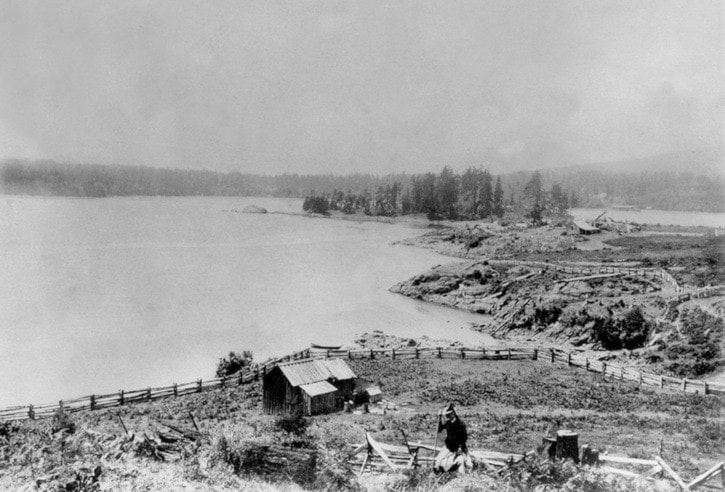The international drama that unfolded here is long forgotten, though commemorated by monuments at Whiffin Spit. In 1790, Spain and Britain crossed swords.
This photo, c1910, was taken from a position near East Sooke Road, west of Tideview, looking towards Woodward Point. Whiffin Spit is out of sight on the left.
The scene encompasses Billy Burnett’s farm; note his cabin in the foreground, barn further back and an enormous amount of split rail fencing bordering the craggy coast. The barn was needed for his horses, as Billy Burnett drove a horse stage between Victoria, Metchosin and the Donaldson farm at the end of East Sooke Road (now Spirit Bear Ranch).
But here’s the drama - this is the spot where the Spanish sub-lieutenant Manuel Quimper anchored his vessel on June 23, 1790, when he sailed into Sooke Harbour and planted a cross for Spain’s King Carlos IV. The sloop Princess Royal had been seized by Spain from Britain’s Meares at Nootka. Renamed Princesa Real, its command was given to Manuel Quimper, who was directed to explore the coast and Strait of Juan de Fuca.
To enter the Sooke inlet through the channel’s currents and eddies, he sailed in the lee of the East Sooke shore. When anchored, the ship served as the base for the longboats of exploration he sent to survey the inlet. Quimper’s log reads “…. three canoes of Indians came out from the port and insisted we should go in .… and it was very good ….”
Quimper named Sooke “Puerta de Revilla Gigedo,” for the Viceroy of Mexico. Later in June, when the sloop left to follow the coastline to our present day Victoria and beyond, the skill of the sailors was put to the test. No auxiliary engines were available of course and the challenge was bringing the vessel back out through the narrow channel between Whiffin Spit and the East Sooke shore.
“Kedging” was the process utilized, the placing of an anchor by longboat some distance ahead of the ship and then the crew hauling on the taut line, pulling the ship forward – if the anchor held. In this way, inch by inch, the ship was moved forward through the channel until it once again reached open water in the Strait and set sail.
Elida Peers, Historian
Sooke Region Museum
